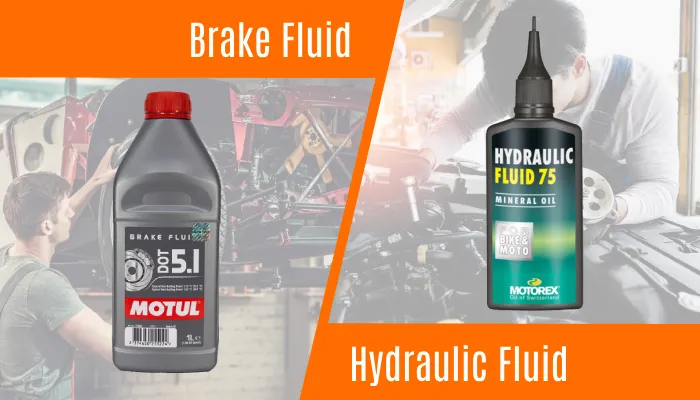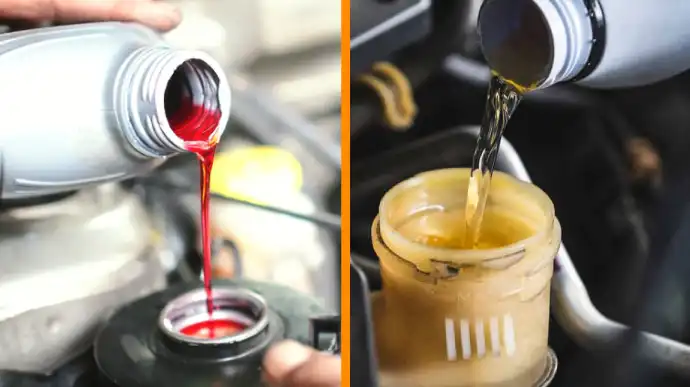Physical Address
304 North Cardinal St.
Dorchester Center, MA 02124
Physical Address
304 North Cardinal St.
Dorchester Center, MA 02124

Brake fluid and hydraulic fluid, though both integral to a vehicle’s operation, serve distinct and critical roles within the automotive ecosystem. Understanding the differences between these two fluids is paramount in vehicle maintenance and safety.
Brake fluid, a specialized variant of hydraulic fluid, plays a pivotal role in the brake system, with a unique set of attributes that ensure reliable stopping power.
In contrast, hydraulic fluids are employed in various vehicle systems, such as power steering and transmissions, each tailored to the specific demands of its application.
This distinction carries significant implications for vehicle safety, performance, and maintenance.
Here, we will look at the key differences between brake and hydraulic fluid. We will expose their compositions, functionalities, standards, and maintenance requirements. So, get ready to become an expert on these vital automotive fluids.

Breaking and Hydraulics are two distinct areas of automotive engineering, each requiring different types of fluids for proper functioning. Here are the main differences between brake and hydraulic fluid:
Brake fluid is specifically formulated for use in vehicle braking systems. It contains additives that prevent corrosion in the brake system. The system ensures efficient force transfer from the brake pedal to the brakes, allowing for reliable stopping power.
In contrast, hydraulic fluid is a more general term for fluids in various vehicle hydraulic systems. It includes automatic transmissions, power steering, and suspension systems. Because it lacks additives, it is unsuitable for high-performance braking systems.
Under these shear conditions, brake fluid is specially designed to resist viscosity loss and maintain its performance. It undergoes rigorous testing to ensure that it can withstand the high shear forces generated during braking without degrading.
On the other hand, hydraulic fluids used in other systems aren’t formulated with the same emphasis on shear stability. While they may be able to handle some level of shear forces, they don’t perform as well as brake fluid in these conditions.
Brake fluid is specially formulated to have a significantly higher boiling point than hydraulic fluid. With a boiling point often exceeding 400°F/204°C, brake fluid is designed to withstand the extreme heat generated during braking. This high boiling point prevents the fluid from vaporizing and ensures consistent brake performance.
Conversely, hydraulic fluid usually has a lower boiling point of 360°C/680°F. This lower boiling point can lead to vaporization and decreased performance under the high-temperature conditions of a brake system.

Regarding moisture absorption, a key difference between brake fluid and hydraulic fluid for vehicles lies in their respective properties.
Brake fluid is designed to be hygroscopic, meaning it has the ability to readily absorb moisture from the atmosphere. This characteristic is actually beneficial for brake fluid, as it helps prevent water from accumulating in the brake system.
When the brakes are applied, the absorbed moisture can be expelled through the system, ensuring that water doesn’t negatively impact braking performance.
Alternatively, hydraulic fluid typically doesn’t possess the same moisture-absorbing properties. This makes hydraulic fluid less suitable for brake systems, as water can harm the overall performance and safety of the brakes.
You should never mix brake fluid and hydraulic fluid in a vehicle. Brake fluid is specifically formulated to be compatible with the rubber seals and components commonly found in brake systems.
Mixing brake fluid with hydraulic fluid can lead to brake system damage or failure, compromising the safety and performance of your vehicle.
On the other hand, hydraulic fluid may not be compatible with the rubber components used in brake systems. If hydraulic fluid is mixed with brake fluid, it can cause deterioration and leakage, further compromising the integrity of the brake system.
Brake fluid is subject to specific standards set by organizations like the Society of Automotive Engineers (SAE), the International Organization for Standardization (ISO), and the Federal Motor Vehicle Safety Standards (FMVSS). These standards ensure that brake fluid meets certain performance and safety requirements.
Meanwhile, hydraulic fluid for various vehicle systems may not be subject to the same stringent standards and ratings that brake fluid is. While hydraulic fluid still needs to meet certain specifications, the requirements may not be as strict as those for brake fluid.
In the case of brake fluid, the presence of water can significantly reduce its boiling point. This is a critical issue because when brake fluid boils, it can create gas bubbles that compress and make the brakes less responsive. Regular maintenance and replacement of brake fluid are essential to prevent this problem.
On the other hand, the impact of water in hydraulic fluid for non-brake systems isn’t as pronounced. The demands and standards for these systems differ from those of the braking system.
While water can still affect the overall performance of hydraulic fluid, it may not have the same detrimental effect on system responsiveness.
Regular maintenance and replacement are crucial for ensuring the optimal performance and longevity of both brake fluid and hydraulic fluid in your vehicle.
Brake fluid should be replaced every few years, following the manufacturer’s recommendations. This interval varies, typically between two to three years or after covering a certain mileage, such as 45,000 miles.
Then again, hydraulic oil replacement is generally required every 4 to 5 years. However, various factors can influence the exact duration, including vehicle type, climate, driving conditions, maintenance practices, and other relevant factors.
Unlike brake fluid, there’s no universally defined time frame for changing hydraulic oil.
| Characteristic | Brake Fluid | Hydraulic Fluid |
| Composition and Purpose | Formulated for brake systems | A general term for various vehicle hydraulic systems |
| Shear Stability | Engineered for high shear stability within the braking system. | Shear stability is not a primary concern for hydraulic fluids in other systems. |
| Boiling Points | High boiling point exceeding 400°F/204°C | Lower boiling point, typically around 360°C/680°F |
| Moisture Absorption | Hygroscopic, absorbs moisture to prevent water accumulation in the brake system. | Typically not moisture-absorbing, making it less suitable for brake systems. |
| Compatibility and Mixing | Compatible with rubber brake system components, should not be mixed with other brake fluids. | Not be compatible with brake system rubber components and should not be mixed with brake fluid. |
| Standards and Ratings | Subject to specific industry standards and safety ratings. | The standards may not be as strict as brake fluid. |
| Response to Water Content | Water in brake fluid affects boiling point and responsiveness, requiring regular replacement. | Given the different system demands, water in hydraulic fluid may not have the same pronounced impact. |
| Maintenance and Replacement | Recommended replacement every 2 years based on the vehicle manufacturer’s guidelines. | Replacement interval is typically around 4 to 5 years but varies based on vehicle type, climate, and other factors. |

It’s typically mineral oil or water-based hydraulic fluid.
Mineral oil-based hydraulic fluids are widely used due to their excellent lubricating properties, thermal stability, and resistance to oxidation and foaming. These fluids can withstand high pressures and temperatures, making them suitable for heavy-duty applications.
Conversely, water-based hydraulic fluids are preferred when fire resistance and environmental friendliness are important factors. These fluids are less flammable and less toxic than mineral oil-based fluids. Additionally, water-based hydraulic fluids offer good cooling properties and are less likely to damage rubber seals and hoses.
Using hydraulic fluid in your brake system in an emergency isn’t recommended due to safety and performance concerns.
Brake fluid is specifically formulated with a high boiling point and additives to prevent corrosion. It’s designed to withstand the high temperatures generated during braking, ensuring optimal braking performance.
Meanwhile, hydraulic fluid isn’t formulated to meet the same specifications as brake fluid. Its lower boiling point leads to brake fade and decreased braking efficiency.
Brake fluid, when new, can have a clear or yellowish tint, but as it ages, it darkens and takes on an oil-like appearance. The color of brake fluid is an important indicator of its condition. Fresh brake fluid is typically transparent or slightly yellowish due to the additives used in its formulation.
As the fluid ages, it can darken to a brown or even black color, indicating contamination and the presence of impurities. This darkening occurs due to the absorption of moisture and the accumulation of dirt and debris.
You can mix different brands of brake fluid in your vehicle as long as they meet the same DOT specifications. DOT specifications refer to the standards the Department of Transportation sets for brake fluids. These specifications ensure the brake fluid meets certain performance requirements, such as boiling point and viscosity.
Now you know the basic differences between brake fluid and hydraulic fluid. Brake fluid, with its high boiling point, anti-corrosion properties, and unique compatibility with the brake system, is essential to vehicle safety.
Conversely, hydraulic fluids cater to various subsystems within a vehicle, offering versatility but lacking the specific properties required for efficient braking.
Understanding these differences is not merely a matter of technicality but a matter of safety and optimal vehicle performance. Using the right fluid in the right system remains crucial as automotive technology evolves.